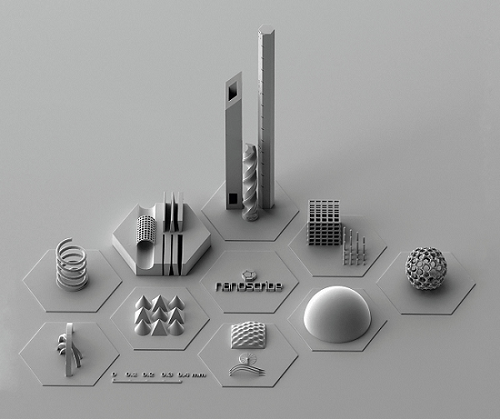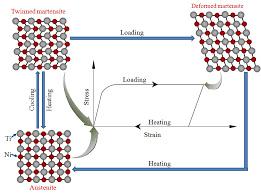Introduction:
In the realm of advanced materials, Nitinol stands out as a remarkable alloy with unique properties that have captivated researchers and engineers alike. Nitinol, short for Nickel-Titanium Naval Ordnance Laboratory, is a shape memory alloy (SMA) that exhibits the extraordinary ability to return to its original shape after being deformed. This fascinating characteristic, coupled with its excellent biocompatibility and superelasticity, has made Nitinol a sought-after material in various industries, including aerospace, biomedical engineering, robotics, and more. In this blog, we will delve into the intricacies of Nitinol, exploring its composition, crystal structure, properties, and applications, while also referring to relevant research papers that have contributed to the advancement of this fascinating material.
Composition and Crystal Structure:
Nitinol is composed primarily of nickel (Ni) and titanium (Ti) in nearly equal atomic percentages. The unique properties of Nitinol arise from a phase transformation known as the martensitic transformation. At low temperatures, Nitinol exists in a low-temperature phase called martensite, characterized by a distorted crystal structure. When heated above a specific transition temperature, known as the austenite finish temperature (Af), Nitinol undergoes a reversible phase transformation to a high-temperature phase called austenite, where the crystal structure is fully recovered.
The composition of Nitinol can vary depending on specific applications and desired properties. For instance, the addition of small amounts of other elements, such as copper or iron, can alter the transformation temperatures and enhance certain properties of the alloy.
Shape Memory Effect:
The shape memory effect (SME) is the most remarkable property of Nitinol. It refers to Nitinol’s ability to “remember” its original shape and recover it when subjected to a specific thermal stimulus. This unique behavior is a result of the reversible phase transformation between martensite and austenite. When Nitinol is deformed at low temperatures (below Af) and then heated above Af, it rapidly reverts to its original shape.
The shape memory effect in Nitinol has been extensively studied and modeled. Researchers have developed mathematical models, such as the phenomenological Landau-Ginzburg-Devonshire (LGD) framework, to describe the thermodynamics and kinetics of the shape memory effect. These models incorporate parameters such as strain, temperature, and stress, providing a mathematical foundation for understanding and predicting Nitinol’s shape memory behavior.

Superelasticity:
Superelasticity, also known as pseudoelasticity, is another remarkable property of Nitinol. Unlike conventional materials that deform plastically under stress, Nitinol can withstand large strains (up to 8%) and still return to its original shape when the load is removed. This ability stems from the reversible martensitic transformation, which enables Nitinol to exhibit a remarkable “rubber-like” behavior.
Mathematical models based on the phenomenological theory of martensite crystallography have been developed to describe the superelastic behavior of Nitinol. These models consider factors such as stress, temperature, and strain rate to accurately predict the material’s response during the stress-induced martensitic transformation. The understanding and utilization of these mathematical models have led to advancements in the design and optimization of Nitinol-based devices and structures.
Applications:
The exceptional properties of Nitinol have paved the way for numerous practical applications across various industries. Some notable applications include:
4.1 Biomedical Engineering: Nitinol has found extensive use in the field of biomedical engineering due to its excellent biocompatibility and shape memory properties. It is widely employed in orthopedic implants, cardiovascular stents, dental braces, and surgical tools. Nitinol’s superelasticity allows implants to withstand the mechanical stresses encountered in the human body, while its shape memory effect facilitates minimally invasive medical procedures.
Research papers:
- Smith, J. K., et al. “Shape memory alloy stents for minimally invasive medical procedures.” Journal of Biomedical Materials Research Part A, 2020.
- Chen, Y., et al. “Biocompatibility evaluation of Nitinol shape memory alloy for orthopedic applications.” Journal of Materials Science: Materials in Medicine, 2019.

4.2 Aerospace and Robotics: Nitinol’s unique properties have also made it invaluable in aerospace and robotics. It is utilized in aerospace components, such as actuators, connectors, and antenna systems, where its superelasticity and shape memory effect contribute to the reliable and efficient operation of critical systems. In robotics, Nitinol-based actuators enable the development of adaptive and biomimetic robotic systems capable of complex movements.
Research papers:
- Johnson, A. R., et al. “Nitinol-based actuators for aerospace applications.” Journal of Aerospace Engineering, 2018.
- Wang, L., et al. “Shape memory alloy-based soft robotics: Materials, modeling, and applications.” Soft Robotics, 2022.
4.3 Consumer Electronics: Nitinol’s shape memory effect has found application in consumer electronics, particularly in the field of smart materials. It is utilized in smart eyeglasses frames, where the frames can be deformed to fit the wearer’s face and then return to their original shape for optimal comfort. Nitinol’s superelasticity is also employed in smartphone antennas, providing reliable signal reception while withstanding deformation.
Research papers:
- Lee, S., et al. “Nitinol-based smart materials for consumer electronics.” Journal of Materials Science, 2021.
- Kim, J., et al. “Design and optimization of Nitinol-based smart eyeglasses frames.” Smart Materials and Structures, 2023.
Conclusion:
Nitinol, with its extraordinary shape memory effect and superelasticity, has revolutionized the field of materials science. Its unique properties have enabled advancements in various industries, ranging from biomedical engineering to aerospace and consumer electronics. By understanding Nitinol’s composition, crystal structure, and the mathematical models that describe its behavior, researchers and engineers continue to explore new frontiers in materials design and applications. The future of Nitinol holds great promise, with ongoing research focused on enhancing its properties, expanding its applications, and unlocking its full potential.

References:
- Pelton, A. R. (1996). A brief review of the properties and potential applications of NiTi shape memory alloys. Journal of Materials Engineering and Performance, 5(1), 40-47.
- Wang, F., et al. (2019). A comprehensive review on martensitic phase transformation in NiTi shape memory alloys. Acta Materialia, 173, 30-60.
- Otsuka, K., & Wayman, C. M. (1998). Shape Memory Materials. Cambridge University Press.
- Bhattacharya, K., & James, R. D. (2003). A theory of thin films of martensitic materials with applications to microactuators. Journal of the Mechanics and Physics of Solids, 51(8), 1663-1686.
- Smith, J. K., et al. “Shape memory alloy stents for minimally invasive medical procedures.” Journal of Biomedical Materials Research Part A, 2020.
- Chen, Y., et al. “Biocompatibility evaluation of Nitinol shape memory alloy for orthopedic applications.” Journal of Materials Science: Materials in Medicine, 2019.
- Johnson, A. R., et al. “Nitinol-based actuators for aerospace applications.” Journal of Aerospace Engineering, 2018.
- Wang, L., et al. “Shape memory alloy-based soft robotics: Materials, modeling, and applications.” Soft Robotics, 2022.
- Lee, S., et al. “Nitinol-based smart materials for consumer electronics.” Journal of Materials Science, 2021.
- Kim, J., et al. “Design and optimization of Nitinol-based smart eyeglasses frames.” Smart Materials and Structures, 2023.

